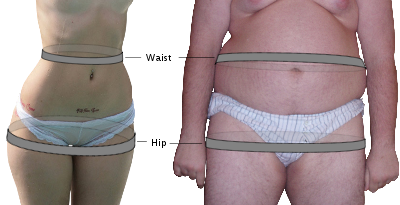腰臀比
腰臀比(Waist-hip ratio,WHR)是指腰围和臀围的比值(无量纲比);其数值等于腰围除以臀围(W⁄H)。


WHR已被用作健康的衡量标准,也与生育能力、身体吸引力相关;但其最佳值,男性和女性并不相同。
量度
编辑严格来说,根据世界卫生组织的数据收集协议[1],腰围是在最后可触知肋骨下缘与髂嵴上缘,两者中点的水平量度。
臀围则是在双腿并拢时以臀部最宽处的水平量度[2]。
实际上,以腰部最小圆周处(自然腰部,natural waist,通常位于肚脐上方)作为腰围值更方便简单,而同样地臀围可采用臀部或髋关节最宽部分的数值[3]。如果腰部因怀孕或肥胖而凸出,腰围则以肚脐以上1英寸垂直水平处的圆周值代替。[4]
健康指标
编辑腰臀比被用作衡量健康和出现严重健康风险的指标,研究发现重量集中在腰部的人较重量集中在臀部的人面临更多的健康风险。腰臀比是用来测量肥胖,尤其是腹部肥胖,因而可作为其他较严重健康状况的指标。男性和女性的标准比分别是0.9和0.7,与一般健康和生育能力有极大关连,腰臀比约0.9的男性较少出现前列腺癌和睾丸癌[5],而腰臀比约0.7的女性具有最佳的雌激素水平,较少出现糖尿病、心血管疾病和卵巢癌[6]。
相对于腰围和身高体重指数(BMI),腰臀比更能有效预测中老年人的死亡率[7]。如果以腰臀比取代BMI用来定义肥胖,全球被归类为心脏病高危的人数将增加三倍[8]。体脂肪率被认为是一个更精确的重量值。在这三个测试中,只有腰臀比需要考虑身体结构的差异,因此不同BMI的人可能有相同腰臀比,或者相同BMI的人可能有不同腰臀比。纵观出现在不同古代文明画像的女性,她们绝大部分的腰臀比介乎0.6至0.7,显示低腰臀比较受欢迎[9]。其他研究则发现,腰围而非腰臀比是心血管危险因素[10]、体脂分布[11]和2型糖尿病高血压[12]的良好指标。
吸引力
编辑1993年,在德克萨斯州大学奥斯汀分校任教的演化心理学家黛文德拉·辛格首先提出腰臀比作为吸引力指标的概念和意义[13][14],辛格认为腰臀比较胸腰比(BWR)更能反映雌激素水平[15][16]。
研究人员发现,腰臀比是一个衡量女性吸引力的重要因素[17],受印欧文化影响的男性普遍把腰臀比0.7的女性评为更具吸引力[18],尽管美女明星如玛丽莲梦露和索菲亚罗兰的身高和体重不同,她们的腰臀比都接近0.7。根据一些研究显示,其他文化的喜好似乎有所不同[19],从中国较低的0.6[20]至南美洲和非洲的0.8或0.9[5][21][22]研究人员也注意到人们的不同喜好源于种族,而非国籍。[23][24]。与臀围尺寸相比,男性似乎更重视女性的腰围尺寸︰
“臀部尺寸显示骨盆的大小和额外储存作为能量来源的脂肪,腰围尺寸则传达有关生殖或健康状况的信息...西方社会没有季节性缺乏食物风险的,因此在衡量一个女性的吸引力时腰围较臀围重要。”
——《生物心理学杂志》,[25]
为了提高吸引力,一些女士可能人为地改变腰臀比外观,包括使用紧身衣以减少腰围外观、使用垫塞增加臀部外观。紧身胸衣和腰带制造商在20世纪试图把吸引力计算为臀围减去腰围[26],但这种计算方法因结果不精确而被弃用,例如臀围较腰围少10英寸(250毫米)对一个肥瘦正常的成年女性有相当的吸引力,但相同的数字对于一个孩子或娇小的女子则可能被视为营养不良。
智商
编辑孩子的认知能力与母亲的腰臀比有一定关系。研究人员利用美国国家卫生统计中心的数据,发现孩子在认知测试中的表现与母亲的腰臀比有关[27],得分最高孩子的母亲有宽臀和低腰臀比,从而推测胎儿受益于臀部脂肪,这些脂肪含有多不饱和脂肪酸长链,对胎儿的大脑发展有关键的作用[27]。此外,有证据显示低腰臀比的儿童较少出现未成年生育常见的认知功能缺陷。
参考文献
编辑- ^ STEPwise approach to surveillance (STEPS). World Health Organization. [March 21, 2012]. (原始内容存档于2017-12-09).
- ^ T. S. Han, E. M. van Leer, J. C. Seidell, M. E. Lean. Waist circumference action levels in the identification of cardiovascular risk factors: prevalence study in a random sample. BMJ (Clinical research ed.). 1995-11-25, 311 (7017): 1401–1405 [2019-02-13]. ISSN 0959-8138. PMC 2544423 . PMID 8520275. (原始内容存档于2018-11-24).
- ^ Waist To Hip Calculator 互联网档案馆的存档,存档日期2011-04-08. at University of Maryland Medical System. Retrieved Dec 2010
- ^ [1] (页面存档备份,存于互联网档案馆) Brown JE; Potter JD; Jacobs DR; et al. Maternal waist-to-hip ratio as a predictor of newborn size: Results of the Diana Project. Epidemiology. January 1996, 7 (1): 62–6. PMID 8664403.
- ^ 5.0 5.1 Marlowe, F.W.; Apicella, C.L.; Reed, D. Men’s Preferences for Women’s Profile Waist-Hip-Ratio in Two Societies (PDF). Evolution and Human Behavior. 2005, 26: 458–468. doi:10.1016/j.evolhumbehav.2005.07.005. (原始内容 (PDF)存档于2014-06-01).
- ^ The Rules of Attraction in the Game of Love. [2011-02-27]. (原始内容存档于2007-09-29).
- ^ Price GM, Uauy R, Breeze E, Bulpitt CJ, Fletcher AE. Weight, shape, and mortality risk in older persons: elevated waist-hip ratio, not high body mass index, is associated with a greater risk of death. Am. J. Clin. Nutr. August 2006, 84 (2): 449–60. PMID 16895897. 简明摘要.
- ^ Yusuf S; Hawken S; Ounpuu S; et al. Obesity and the risk of myocardial infarction in 27,000 participants from 52 countries: a case-control study. Lancet. November 2005, 366 (9497): 1640–9. PMID 16271645. doi:10.1016/S0140-6736(05)67663-5.
- ^ Singh D. Female mate value at a glance: relationship of waist-to-hip ratio to health, fecundity and attractiveness (PDF). Neuro Endocrinol. Lett. December 2002,. 23 Suppl 4: 81–91 [2011-02-27]. PMID 12496738. (原始内容存档 (PDF)于2021-02-26).
- ^ Dobbelsteyn CJ, Joffres MR, MacLean DR, Flowerdew G. A comparative evaluation of waist circumference, waist-to-hip ratio and body mass index as indicators of cardiovascular risk factors. The Canadian Heart Health Surveys. Int. J. Obes. Relat. Metab. Disord. May 2001, 25 (5): 652–61. PMID 11360147. doi:10.1038/sj.ijo.0801582.
- ^ Ketel IJ, Volman MN, Seidell JC, Stehouwer CD, Twisk JW, Lambalk CB. Superiority of skinfold measurements and waist over waist-to-hip ratio for determination of body fat distribution in a population-based cohort of Caucasian Dutch adults. Eur. J. Endocrinol. June 2007, 156 (6): 655–61. PMID 17535865. doi:10.1530/EJE-06-0730.
- ^ Picon PX; Leitão CB; Gerchman F; et al. [Waist measure and waist-to-hip ratio and identification of clinical conditions of cardiovascular risk: multicentric study in type 2 diabetes mellitus patients]. Arq Bras Endocrinol Metabol. April 2007, 51 (3): 443–9. PMID 17546244 (葡萄牙语).
- ^ Singh D. Adaptive significance of female physical attractiveness: role of waist-to-hip ratio. J Pers Soc Psychol. August 1993, 65 (2): 293–307. PMID 8366421. doi:10.1037/0022-3514.65.2.293.
- ^ Buss, David. The Evolution of Desire: Strategies of Human Mating (hardcover) second. New York: Basic Books. : 56 [2011-02-27]. (原始内容存档于2018-03-16).
- ^ Wilson, G.D. & Brazendale, A.H. Psychological correlates of sexual attractiveness: An empirical demonstration of denial and fantasy gratification phenomena? Social Behavior and Personality 1973,2,30-34.
- ^ Wilson, G.D., Nias D.K.B. & Brazendale, A.H. Vital statistics, perceived sexual attractiveness and response to risque humor. Journal of Social Psychology, 1975,95,201-205.
- ^ Perfect waist-to-hip ratio is 0.7
- ^ Singh, Devendra; Young, Robert K. Body Weight, Waist-to-Hip Ratio, Breasts, and Hips: Role in Judgments of Female Attractiveness and Desirability for Relationships (PDF). Ethology and Sociobiology. 2001-06-27, 16: 483–507. doi:10.1016/0162-3095(95)00074-7. (原始内容 (PDF)存档于2011-11-07).
- ^ Fisher, M.L.; Voracek M. The shape of beauty: determinants of female physical attractiveness.. J Cosmet Dermatol. June 2006, 5 (2): 190–4. PMID 17173598. doi:10.1111/j.1473-2165.2006.00249.x.
- ^ Dixson, B.J.; Dixson A.F.; Li B.; Anderson M.J. Studies of human physique and sexual attractiveness: sexual preferences of men and women in China.. Am J Hum Biol. January 2007, 19 (1): 88–95. PMID 17160976. doi:10.1002/ajhb.20584.
- ^ Marlowe, F.; Wetsman, A. Preferred waist-to-hip ratio and ecology (PDF). Personality and Individual Differences. 2001, 30 (3): 481–489. doi:10.1016/S0191-8869(00)00039-8. (原始内容 (PDF)存档于2014-06-30).
- ^ Dixson, B.J.; Dixson A.F.; Morgan B.; Anderson M.J. Human physique and sexual attractiveness: sexual preferences of men and women in Bakossiland, Cameroon. Arch Sex Behav. June 2007, 36 (3): 369–75. PMID 17136587. doi:10.1007/s10508-006-9093-8.
- ^ Freedman, R.E.; Carter M.M.; Sbrocco T.; Gray JJ. Do men hold African-American and Caucasian women to different standards of beauty?. Eat Behav. August 2007, 8 (3): 319–33. PMID 17606230. doi:10.1016/j.eatbeh.2006.11.008.
- ^ Freedman, R.E.; Carter M.M.; Sbrocco T.; Gray J.J. Ethnic differences in preferences for female weight and waist-to-hip ratio: a comparison of African-American and White American college and community samples. Eat Behav. July 2004, 5 (3): 191–8. PMID 15135331. doi:10.1016/j.eatbeh.2004.01.002.
- ^ Rozmus-Wrzesinska M, Pawlowski B. Men's ratings of female attractiveness are influenced more by changes in female waist size compared with changes in hip size. Biol Psychol. March 2005, 68 (3): 299–308. PMID 15620796. doi:10.1016/j.biopsycho.2004.04.007.
- ^ 存档副本. [2011-02-27]. (原始内容存档于2011-05-24).
- ^ 27.0 27.1 Lassek, W.; Gaulin S. Waist-hip ratio and cognitive ability: is gluteofemoral fat a privileged store of neurodevelopmental resources?. Evolution and Human Behavior. January 2008, 29 (1): 26–34. doi:10.1016/j.evolhumbehav.2007.07.005.
- Waist-hip ratio should replace body mass index as indicator of mortality risk in older people (页面存档备份,存于互联网档案馆) EurekAlert August 8, 2006
- Genes for 'pear shape' found (页面存档备份,存于互联网档案馆), NHS Choices, October 11 2010